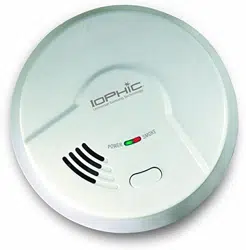Loading ...
Loading ...
Loading ...

Page 7
NUISANCE ALARMS: The smoke alarm is designed to minimize nuisance alarms. Smoking will
not normally set off the alarm unless smoke is blown directly into the smoke alarm. Combustion
particles from cooking may set off the alarm if the smoke alarm is located close to the kitchen
cooking surface. Large quantities of combustion particles are generated from spills or broiling.
If the smoke alarm does sound, check for fires first. If a fire is discovered, get out and call the fire
department. If no fire is present, check to see if one of the reasons listed above may have caused
the alarm. Use the Silence Feature if it is a nuisance alarm, or reset the alarm by pressing and
holding the test button for ten seconds. Refer to RESET on Page 7.
TESTING: Test by pressing test button on the smoke alarm cover until the alarm sounds, then
release. The alarm sounds if all electronic circuitry, horn and battery are working. If no alarm
sounds, the alarm may have a power supply failure. Test the smoke alarm weekly to assure
proper operation. IMPORTANT: Under normal conditions, the test button should sound the alarm
immediately after it is pressed. There are special conditions that when you press the test button,
you will experience a delay of approximately 10-15 seconds before the alarm sounds. This delay
occurs if the test button is pressed during a self-diagnostic period.This occurs: (1) upon initial
power up; (2) after battery replacement (and no AC power is present) and (3) if 120 volt AC
power has been interrupted and no backup battery was present.
ALARM ORIGINATION: QUICK FIND
®
Alarm Origination - In an interconnected system consisting
of any of these models: 5304CN, MI106CN, MDS107CN, MCN108CN, MICN109CN, MDSCN111CN,
MP117CN, it may be difficult to determine which alarm initiated the alarms to sound during an alarm
event. This QUICK FIND
®
feature will immediately allow you to locate the originating alarm once the
alarms have stopped sounding. To initiate QUICK FIND
®
, press the Test/Silence button on any
alarm. After releasing the button, the test sequence on this alarm will begin and last 5-20 seconds,
and then stop. The specific test sequence horn pattern is designated by the alarm type. Once this
test sequence ends, the originating alarm continues to sound for approx. 50 seconds, which provides
ample time to locate the originating alarm. Remember to reset (see Page 10) the originating alarm
in order to clear the QUICK FIND
®
alarm origination and to return your system to normal operation.
Refer to the wiring instructions model interconnect compatibility section of this manual (Page 5) for
additional information. In a non-interconnected installation, it is necessary to test each alarm by
pressing and releasing the Test/Silence button to determine the originating alarm.
RESET: To reset the QUICK FIND
®
Alarm Origination condition, press and hold the Test button
on any alarm for at least 10 seconds and then release. Reset after each alarm. The reset
feature will reset all interconnected units.
END-OF-SERVICE LIFE NOTIFICATION: A majority of home fire deaths are a result of no smoke
alarms or no working smoke alarms. In addition to the "replace by date" stamped on the back of your
alarm, your alarm contains a unique audible end-of-service life notification feature. When it is time
to replace your alarm, which is after approximately 10 years of operation from initial power up, the
alarm will sound 1 beep approx. every 60 seconds and the red LED will blink on once approx. every
40-45 seconds. The green LED stays on. The alarm should be replaced immediately.
The product end-of-service life signal can be silenced for approximately 9 hours. To perform this
function, press and release the test button. The alarm will sound for approximately 60 seconds while
it resets. After the reset function is completed, the alarm will be silent for approximately 9 hours. The
end-of-service life signal will reactivate after the silence period.
NEVER use an open flame of any kind to test this smoke alarm. You might accidentally damage
or set fire to the smoke alarm or to your home. The built-in test switch accurately tests the
smoke alarm's operation as required by Underwriters Laboratories Inc. (UL).
If you choose to use an aerosol smoke product to test the smoke alarm, be certain to use one
that has been Listed to Underwriters Laboratories, Inc. Safety Standards and use it only as
directed. Use of non-UL Listed products or improper use of UL Listed products may affect
the smoke alarm's sensitivity.
NUISANCE ALARM SILENCE FEATURE: This feature is to be used only when a known alarm
condition, such as smoke from cooking, activates the smoke alarm. The smoke alarm Silence
Feature is activated by pushing and releasing the Silence button on the smoke alarm cover while in
alarm condition. The smoke alarm will automatically reduce sensitivity and the red LED will blink on
approx. every 10 seconds to indicate the alarm is in the Silence mode. The smoke alarm will gradually
regain normal sensitivity and sound the alarm if particles of combustion are still present. The 8-12
minute Silence feature may be used repeatedly until the air has cleared, by pushing and releasing
the Silence button again. Resetting the smoke alarm after a nuisance alarm is recommended.
NOTE: If the Test button is pressed and held during the Silence mode, the smoke alarm will be
tested normally. Upon the release of the Test button, the Silence mode will be restarted.
Loading ...
Loading ...
Loading ...
